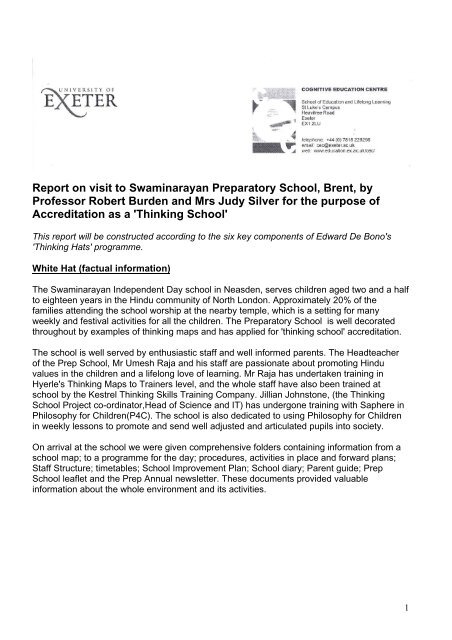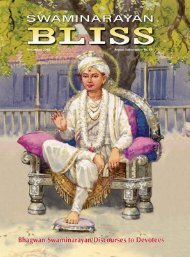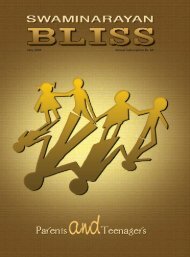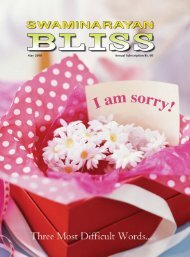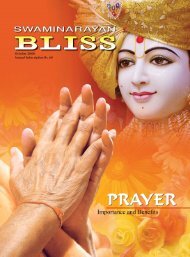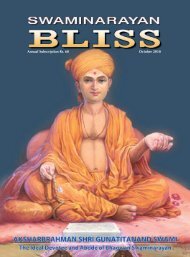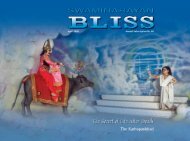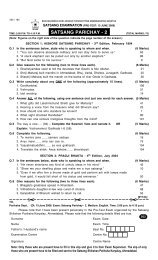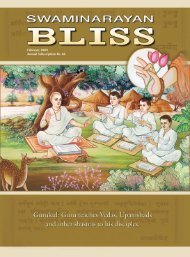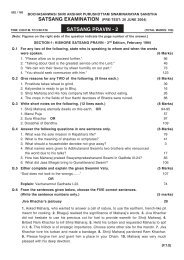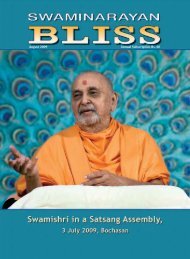Inspection Report - Shri Swaminarayan Mandir
Inspection Report - Shri Swaminarayan Mandir
Inspection Report - Shri Swaminarayan Mandir
Create successful ePaper yourself
Turn your PDF publications into a flip-book with our unique Google optimized e-Paper software.
<strong>Report</strong> on visit to <strong>Swaminarayan</strong> Preparatory School, Brent, by<br />
Professor Robert Burden and Mrs Judy Silver for the purpose of<br />
Accreditation as a 'Thinking School'<br />
This report will be constructed according to the six key components of Edward De Bono's<br />
'Thinking Hats' programme.<br />
White Hat (factual information)<br />
The <strong>Swaminarayan</strong> Independent Day school in Neasden, serves children aged two and a half<br />
to eighteen years in the Hindu community of North London. Approximately 20% of the<br />
families attending the school worship at the nearby temple, which is a setting for many<br />
weekly and festival activities for all the children. The Preparatory School is well decorated<br />
throughout by examples of thinking maps and has applied for 'thinking school' accreditation.<br />
The school is well served by enthusiastic staff and well informed parents. The Headteacher<br />
of the Prep School, Mr Umesh Raja and his staff are passionate about promoting Hindu<br />
values in the children and a lifelong love of learning. Mr Raja has undertaken training in<br />
Hyerle's Thinking Maps to Trainers level, and the whole staff have also been trained at<br />
school by the Kestrel Thinking Skills Training Company. Jillian Johnstone, (the Thinking<br />
School Project co-ordinator,Head of Science and IT) has undergone training with Saphere in<br />
Philosophy for Children(P4C). The school is also dedicated to using Philosophy for Children<br />
in weekly lessons to promote and send well adjusted and articulated pupils into society.<br />
On arrival at the school we were given comprehensive folders containing information from a<br />
school map; to a programme for the day; procedures, activities in place and forward plans;<br />
Staff Structure; timetables; School Improvement Plan; School diary; Parent guide; Prep<br />
School leaflet and the Prep Annual newsletter. These documents provided valuable<br />
information about the whole environment and its activities.<br />
1
The visit began with an observation of School Assembly and a dramatic performance given by<br />
Year 6 students about the use of thinking maps to describe pollution and raise associated moral<br />
questions. This was followed by breakfast with some parents. The parents were totally<br />
supportive of the Thinking Schools project, and spoke enthusiastically about the use of the<br />
maps, not only for schoolwork, but as an aid for family life: shopping, planning family outings.<br />
They also recognised the maps' application to commercial enterprise.<br />
We were then taken on a comprehensive guided tour of the school conducted by Tej Master<br />
and Samanta Zahir, the Prep School Head Boy and Girl. This was followed by observation of<br />
both P4C sessions and Thinking Maps sessions, with Years 2, 4, 5 and 6.<br />
We sat in on Miss Johnstone’s P4C session where children were offered the stimulus of a world<br />
globe to discuss gravity. Miss Johnstone allowed the children to take their ideas where they<br />
wanted rather than have them follow her lead. This was skilfully achieved, demonstrating<br />
restraint and an awareness of the deeper goals of the session. This gentle but firm facilitation<br />
was evident again in Mr. Condely's P4C session with Year 2.<br />
A session with Reception children being introduced the Brace map was also observed. Ms<br />
Divecha, the class teacher first asked one child to take a torch to pieces and label the<br />
constituent parts, and then used this kind of analysis to introduce the task of cutting up a<br />
skeleton into its parts. The children were divided into three groups that sat at tables and on the<br />
carpet. The Reception class has a team of one teacher and two teaching assistants. There was<br />
differentiation, wherein each group had a slightly different task concerned with the cutting up<br />
and analysis of the skeleton. The children appeared engaged and interested in the task and<br />
used appropriate language in their discussions. The teaching assistants told us later that they<br />
liked working as part of a team and were never made to feel inferior or less valued than the<br />
qualified teacher.<br />
Two meetings with children were arranged, from Reception through to Year 6, which was the<br />
highlight of the day - one meeting in the morning and one in the afternoon. Children showed<br />
each other courtesy and respect and listened to each other before they took their turn. Much of<br />
this behaviour could be attributed to conduct learnt in the P4C sessions. It was interesting that<br />
the children in the morning said that they preferred P4C sessions to maps because they did not<br />
have to write anything down. The group in the afternoon told us they could see how maps would<br />
help them for revision and study skills when they got older. They had a lively curiosity about our<br />
own work, and our interest in the school.<br />
2
We were taken into the <strong>Mandir</strong> which was both a privilege and a beautiful experience, and gave a<br />
valuable insight into the practices and religious values of the Hindu culture. Professor Burden<br />
was fortunate to be introduced to Pujya Yogvivek Swami, the Head of the BAPs <strong>Swaminarayan</strong><br />
<strong>Mandir</strong>(Temple) who was gracious in his endorsement of the cognitive approach.<br />
His Holiness Pramukh Swami Maharaj is the inspiration of both the <strong>Mandir</strong> and the school. One<br />
of His quotations which is on the front cover of the school’s prospectus, encapsulates the ethos<br />
of this wonderful school.<br />
I The heart of education is the education of the heart, of the mind and of the spirit. This is not<br />
achieved by chance but brought about by great effort and care, both by the students and the<br />
schooling system that meets their needs. This is a faith school and the Hindu culture and moral<br />
values of the faith are evident in all aspects of the environment, from the welcome we were<br />
offered when we arrived; to the thoughtful refreshments and generosity of our hosts; to the<br />
openness of the staff and parents towards us; to their pride not only in their school but in the<br />
<strong>Mandir</strong>; to the respect and love shown to individual children - and it was clear that Mr Raja is an<br />
exemplary role model for a Head and knows all the children by name. Most important was the<br />
atmosphere of the school which appeared to be calm and business like. The values of the school<br />
are evident in all the classrooms, and moral codes are written and placed around classrooms.<br />
Yellow Hat (significant positive features)<br />
The above comments show the positive aspects of this environment. Another positive aspect is<br />
the performing arts aspect of the curriculum. All children attend yoga, encouraging a disciplined<br />
body and mind. Children are allowed to choose which traditional instrument they wish to study,<br />
and traditional dance is also featured. The quality of the art displayed everywhere is beautifully<br />
sensitive and seems to reflect many aspects of the ethos of the place. The academic standards<br />
achieved by the pupils are clearly high, as is their articulate and appropriate use of language to<br />
express their thoughts and ideas. A recent formal inspection visit has commented upon the<br />
obvious links between the children's achievements and the thinking skills programme.<br />
Black Hat (potential negative features)<br />
No outstanding negative features within the implementation of the school's cognitive curriculum<br />
were detected. At the moment the school is successfully offering a wide range of broader<br />
curriculum activities by extending the length of the school day. This means that the time available<br />
for formal training in thinking skills is often at a premium. This is currently being overcome by<br />
fairly informal communication and interactions between the members of a highly committed staff.<br />
It is important, however, not to let slip regular formal opportunities for sharing examples of good<br />
practice and skills development.<br />
3
Green Hat (possible ways forward)<br />
Monitoring the academic self-esteem of the older Prep School pupils by means of an instrument<br />
such as the Myself-As-Learner Scale (MALS) would provide additional evidence as to the effects<br />
of the cognitive education programme. The natural next step in the school's development<br />
programme is Costa's 'Habits of Mind', which will fit very well with the school's philosophy and<br />
values system. The Prep School itself can certainly stand as a beacon to other schools<br />
elsewhere as exemplifying excellent cognitive practice.<br />
Blue Hat (overall impressions)<br />
The <strong>Swaminarayan</strong> Preparatory School clearly meets all the criteria set by the University of<br />
Exeter's Cognitive Education Centre for the recognition as a 'Thinking School'. It stands as an<br />
outstanding example of excellent practice in this domain.<br />
Robert Burden MA PhD, Dip Ed Psych, FBPsS Emeritus Professor Applied Educational<br />
Psychology<br />
4


